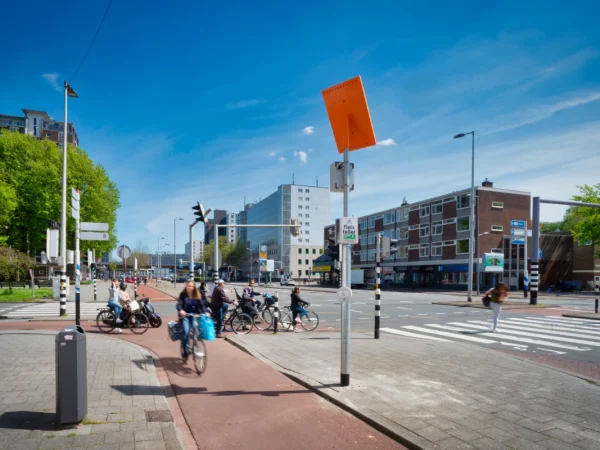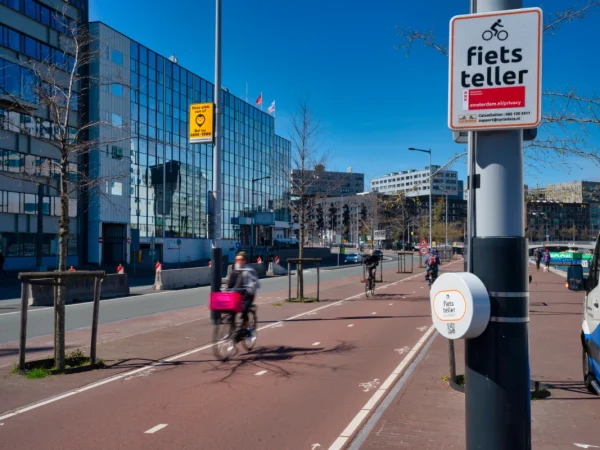Amsterdam gains insight into bicycle mobility with the bicycle counter made by MultiSensors
Every day, as many as 400,000 people in Amsterdam take their bikes to get to their destinations. The popularity of the bicycle continues to grow and with it, the congestion on the bike paths. A challenge for not only the municipality of Amsterdam.
The company MultiSensors asked Ewald Dijkstra, senior advisor mobility research of the team Research and Knowledge at the Traffic and Public Space department of the municipality of Amsterdam , about the challenges in the field of bicycle mobility and why they chose the Signum bicycle counter of MultiSensors.
What are the current mobility challenges within the City of Amsterdam?
“The traffic mobility of cars within the municipality of Amsterdam is well known. Throughout the city there are lots of cameras and sensors that register car traffic and can show how busy it is in certain parts within the city. All this data is used in Amsterdam’s traffic model to make predictions about future, expected traffic intensities.
For the bicycle, this was not possible for a simple reason: there was too little information. The only form of data the municipality received was that from the bicycle loops, the bicycle weeks and from actions such as Ping If You Care. In addition, every other year the municipality does a large-scale survey in which all mobileits forms and quantities are counted at about one hundred and fifty locations. The problem with all these data, however, is that they are snapshots. No conclusion can be drawn from them as to how these numbers compare to other times of the year.
Especially during peak hours and during bicycle jams, when cyclists were standing still around the loop, it appeared that the counts of bicycle loops deviated significantly from reality (Bicycle loops are a measurement system with a loop in the bike path). In addition, the municipality uses counting tubes for temporary surveys. For permanent use, however, these are too fragile.
Increasingly busy bicycle paths, challenges with bicycle parking and the rise of faster (moped/electric) bicycles require reliable data that provide a picture of bicycle flows and bicycle intensity throughout the year. With reliable and complete data, the City of Amsterdam gets a real picture of the actual bicycle crowding in the city.”
How does MultiSensors’ Signum telradar help with that?
“So the City of Amsterdam needed a reliable system in which at least the relative crowding on a bike path could be determined. In other words, a system that can measure bicycle intensity all year round. With the installation of the Signum telradars, the municipality now has year-round, 24/7 insight into the amount and speed of cyclists passing a given point. This data can be viewed real-time (live) at an aggregated and anonymized level.
The Signum telradar also proves to be a more reliable alternative than manual counts. A comparative study was done at a pilot site (comma away) to verify reliability. The results were very positive. The Signum was found to have a reliability score well above 90%. Even during peak hours and during bicycle congestion, the reliability of the radar remained above 90%.”
What are the data used for, (comma away) that the Signum telradars generate?
“The data are used to measure traffic safety on the bike lanes and gain insight into the various bottlenecks on the bike lanes. The data also help in being able to make the bike lanes safer and be able to optimize the flow of cyclists.”
How did the implementation of the Signum telradars work?
“The implementation of the Signum telradars went well. MultiSensors installed the sensors for the municipality of Amsterdam, which meant the municipality had nothing to worry about. We were then able to easily get all the data at the municipality in the online dashboard. An advantage of the dashboard is that it is clear and simple. You can see per measuring point clearly, easily and in detail what the traffic intensity is.”
Any advice for other municipalities that want to gain more insight into their bicycle mobility?
“When distributing the data, make sure it is bundled in five-minute blocks (busy locations) or multiples of that ( quiet locations). This will make you AVG-compliant as a municipality and the measurement points cannot be traced back to an individual. Before clustering the data, take a short time interval to get the most detailed snapshot possible.
In addition, it is important to investigate whether there is a need for a continuous measurement, or a periodic measurement, such as at the beginning of the school year or during an event. The advantage of a continuous measurement is that it can be used to determine the relative crowding on a bike path. With a periodic measurement, other factors such as events or weather can affect the measurement.”



